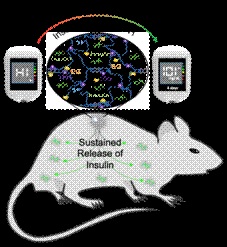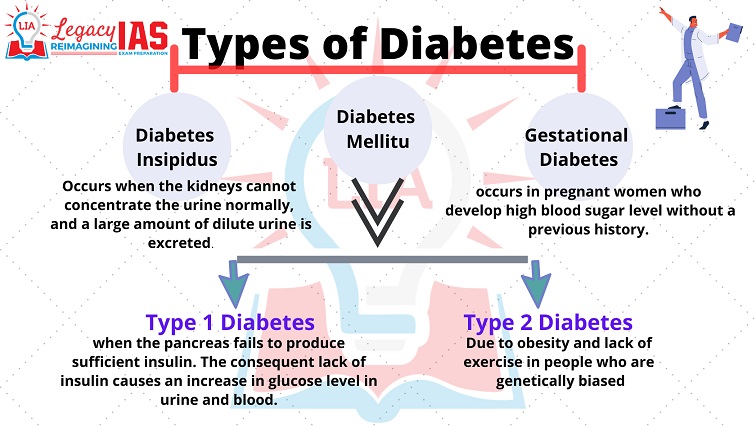Contents
- Injectable Silk Fibroin-based Hydrogel for sustained Insulin
- Lightweight carbon foam that can replace lead batteries
- GoI & AIIB sign agreement for USD 145 million
INJECTABLE SILK FIBROIN-BASED HYDROGEL FOR SUSTAINED INSULIN
Focus: GS-III Science and technology, Prelims
Why in news?
Scientists have developed the silk fibroin (SF) formulation using biocompatible additives and prepared an injectable SF hydrogel (iSFH) that can ease insulin delivery in diabetic patients. The iSFH has demonstrated successful delivery of active insulin in rats, and the results have been published in the journal ACS Applied Bio Materials.
Details:
Diabetes affects more than 70 million people in India, the second-highest in the world.
It results from inadequate production of insulin due to loss of beta cells or insulin resistance within the body, which imbalances the glucose homeostasis is leading to an abrupt increase of blood glucose level.
Scientists have shown that subcutaneous injection of insulin with-iSFH in diabetic rats formed active depot under the skin from which insulin trickled out slowly and restored the physiological glucose homeostasis for a prolonged period of 4 days with no risks of low blood sugar through sudden burst of high concentration of insulin into the blood.

- The conventional and last resort of treatment involves repeated subcutaneous insulin injections to maintain the physiological glucose homeostasis.
- The multiple subcutaneous insulin injections are associated with pain, local tissue necrosis, infection, nerve damage, and locally concentrated insulin amyloidosis responsible for inability to achieve physiological glucose homeostasis.
- This problem can be overcome with controlled and sustained insulin delivery.
- Thus, encapsulation and sustained delivery of insulin in its active form (without loss of activity) is the key to the development of such controlled and sustained in vivo delivery of Insulin.
- The iSFH has proved to be an effective insulin delivery tool for diabetic patients with excellent mechanical strength, biocompatibility, encapsulation, storage, and demonstration of its sustained delivery of active insulin in the diabetic animal.
- The active encapsulation and delivery of insulin by iSFH may also have implications for the future development of formulations for oral insulin delivery.
What is Diabetes?
Diabetes is a metabolic disease or a condition in which the glucose levels in the blood will be high over a prolonged period of time. That means it can be defined as a condition that occurs when the body cannot efficiently make use of glucose that serves as a source of energy for body cells. Blood sugar levels are controlled by a hormone called insulin.

LIGHTWEIGHT CARBON FOAM THAT CAN REPLACE LEAD BATTERIES
Focus: GS-III Science and Technology
Why in news?
CSIR-Advanced Materials and Processes Research Institute, Bhopal is developing porous carbon materials which have the potential to replace lead grid in lead-acid batteries.
Details:
- There are some serious concerns regarding Li-ion batteries, such as safety risk, limited resource supply, high cost, and lack of recycling infrastructure.
- This necessitates the development of an alternative battery system with lower environmental concerns, economic and higher energy density.
As a result, lead-acid batteries are still one of the most reliable, economical, and environmentally friendly options. - However, electrodes in the lead-acid batteries suffer from the problem of heavyweight, corrosion, poor thermal stability, and diffusion of electrolytes in one dimension, which ultimately affects the output power.
- Scientists have developed lightweight carbon foam with a density of less than 0.3g/cc, high porosity of over 85%, good mechanical strength.
- The carbon foam developed will also be cost-effective for the removal of arsenic, oil, and other metals from contaminated water. These carbon foams are non-toxic, easy to fabricate, affordable, and insoluble in water.
- The raw material for the fabrication of carbon foam is easily available everywhere, and there is no requirement of any costly equipment for the fabrication of carbon foam and filtration. Such materials can be safely used in remote areas where power supply is scarce.
Related Article: Lithium-ion batteries
GoI & AIIB SIGN AGREEMENT FOR USD 145 MILLION
Focus: GS-III Industry and Infrastructure, Economy
Why in news?
The Government of India, the Government of West Bengal and the Asian Infrastructure Investment Bank (AIIB) today signed a loan agreement for a US$145 million project to improve irrigation services and flood management in the Damodar Valley Command Area (DVCA) in West Bengal.
Details:
- The West Bengal Major Irrigation and Flood Management Project will benefit about 2.7 million farmers from five districts of West Bengal across 393,964 ha area with better irrigation services and improved protection against annual flooding to mitigate the impact of climate change.
This investment is focused on improving the livelihood of farmers and boosting the regional economy. The project will help thousands of farmers get adequate water by improving the irrigation efficiency through infrastructure rehabilitation and modernization.
- To deal with these challenges, several institutional reforms are planned under the project.
- These include introduction of a modern Management Information System (MIS), benchmarking and evidence-based decision making, promotion of conjunctive use of surface and groundwater, introduction of rational asset management and improving transparency through citizen engagement.
Irrigation Service Providers will be recruited on a performance basis to improve the quality of irrigation services.
The total value of the project is $413.8 million, co-financed between the AIIB ($145 million), IBRD ($145 million) and the Government of West Bengal ($123.8 million).
About Asian Infrastructure Investment Bank:
- The Asian Infrastructure Investment Bank (AIIB) is an international financial institution proposed by China. The purpose of the multilateral development bank is to provide finance to infrastructure projects in the Asia-Pacific region.
- It is headquartered in Beijing.
- It commenced operations in January 2016.
- By investing in sustainable infrastructure and other productive sectors today, it aims to connect people, services and markets that over time will impact the lives of billions and build a better future.
Membership of AIIB
Membership in the AIIB is open to all members of the World Bank or the Asian Development Bank and is divided into regional and non-regional members.
- Regional members are those located within areas classified as Asia and Oceania by the United Nations.
- Unlike other MDBs (multilateral development bank), the AIIB allows for non-sovereign entities to apply for AIIB membership, assuming their home country is a member.
- Thus, sovereign wealth funds (such as the China Investment Corporation) or state-owned enterprises of member countries could potentially join the Bank.
- The China-led Asian Infrastructure Investment Bank (AIIB) has officially approved 57 nations as prospective founding members, with Sweden, Israel, South Africa, Azerbaijan, Iceland, Portugal and Poland the latest to be included.
- Countries accepted as AIIB founding members include China, India, Malaysia, Indonesia, Singapore, Saudi Arabia, Brunei, Myanmar, the Philippines, Pakistan, Britain, Australia, Brazil, France, Germany and Spain.
- Founding members have priority over nations that sign up later because they will have the right to set the rules for the bank.
- As of May, 2020, the bank currently has 78 members as well as 24 prospective members from around the world.
Financial Capital of AIIB:
- The AIIB’s initial total capital is USD 100 billion divided into 1 million shares of 100 000 dollars each, with 20% paid-in and 80% callable.
- Paid-Up Share Capital: It is the amount of money that has already been paid by investors in exchange for shares of stock.
- Called-Up Share Capital: Some companies may issue shares to investors with the understanding they will be paid at a later date.
- This allows for more flexible investment terms and may entice investors to contribute more share capital than if they had to provide funds up front.
- China is the largest contributor to the Bank, contributing USD 50 billion, half of the initial subscribed capital.
- India is the second-largest shareholder, contributing USD 8.4 billion.
- Voting Rights:
- China is the largest shareholder with 26.61 % voting shares in the bank followed by India (7.6%), Russia (6.01%) and Germany (4.2 %).
- The regional members hold 75% of the total voting power in the Bank.



